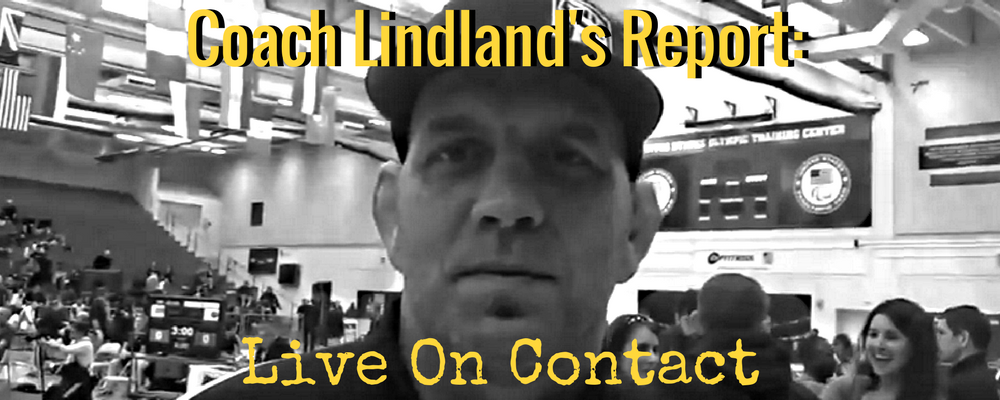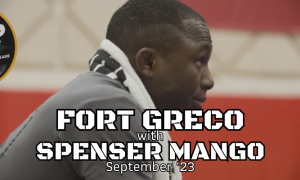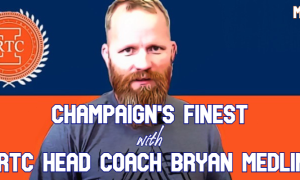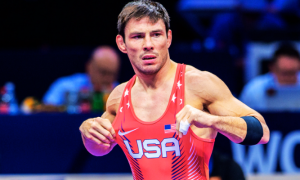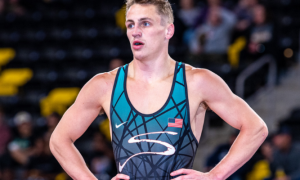Five Point Move is proud to host US Greco-Roman National Team Head Coach Matt Lindland every week for “Coach Lindland’s Report.” For fans and wrestlers looking for insights regarding the US Greco National Team, we ask Coach Lindland questions pertaining to recent events, training, and other topics surrounding the sport of Greco-Roman. If you have any questions of your own you’d like us to ask going forward, let us know via Facebook, Twitter, or through our Contact page.
This week, we talk to Coach Lindland following the first week of World Team Camp for the Seniors at the Olympic Training Center. A breakdown of the curriculum as well as some of the bullet points and intentions of the camp as a whole are obviously talked about, but there are some other topics thrown in also. And since it’s World Championships Week for the Juniors, we delve into why Team USA is poised for a breakthrough in Finland and what he likes the most about the squad leading up.
5PM: Let’s start personal — what does running World Team Camp remind you about your own career, being in the same position as the athletes during that last push to either the Worlds or the Olympics?
Coach Matt Lindland: It does remind me of the gravity of the event. You’re going to a major international event and these are the best guys in the world. Arguably, we gear up for the Olympic Games every four years, but a World Championships is a very deep event. On some occasions, it is definitely harder to win a World medal than an Olympic medal.
There is so much focus on the individual who is going and I am very aware of the fact that I don’t want to beat my guys down. But I want them to get enough pressure to create something good out of this, like how they say diamonds are created out of pressure. You have to instill that pressure in these athletes. There is a fine line between putting too much pressure on them and tempering them, so you use the right amount for the competition.
That’s what it reminds me about the most. Sometimes, you can overdose on that amount of pressure and we’ve seen it happen. Guys, they’ll crack, but the most resilient athletes will be back not even next practice, they will be back in two minutes from when they crack. Some guys, it might take them a day, but we don’t want to break anybody, for sure. We just want to prepare them and keep them healthy, excited, hungry, and able to go out there and compete.
5PM: What have been the highlights from the first week that have left you confident and upbeat?
ML: Everybody is putting out their maximum efforts. I think the hard thing is that Robby (Smith) has a staph infection, so he’s missed a couple of practices here. Ellis (Coleman) has been dealing with some stomach stuff, some kind of bug is going around. I would love it if we had everybody at every practice and we weren’t missing a couple of guys. But I think the good stuff is when everybody is healthy, on the mat, and putting out maximum effort. They’re working together as a team. And I’m seeing them score, I’m seeing them execute, and that’s really the big theme of this camp, putting points on the board. We can’t rely on our one chance on top in par terre. We’ve got to score. We can’t leave it up to the officials. Look what happened to Pat (Smith) over in Tbilisi. He didn’t get the calls, he didn’t get the passivity calls, and he loses the match.
So we’ve got to change that into scoring. Level changes, getting to the body, and executing our techniques. We’re seeing our guys make those attempts. We’re seeing them creating those opportunities more to where they’re putting themselves in position to score. Ben (Provisor) has his duck under going and I think he’s going to hit that on everybody. Pat’s got his arm drag to get to the body. There’s lots of good stuff like that happening, because you have to have your go-to move. Everybody has that move and even though the other guy knows you’re going to hit it, you’re still going to be able to execute it under pressure. And I think that is what I’m seeing that I like the most.
5PM: Since there is such an impetus on scoring, is it on both the coach and athlete, coming up with cues for guys to hit moves in certain situations to create that urgency?
ML: Yeah, I think that’s a great question but if the coach has time to yell it, the position is probably not there anymore, unfortunately. So what you are saying to the athlete is, Head up, keep moving your legs, create your angles. Because he has to see it. He has to sense it and feel it. It’s not like a lightbulb goes on and he says, Oh, there’s my arm drag. It’s all of those things. Creating the right pressure on your opponent without giving up balance or positioning in any sense. It’s also about constantly moving and if you’re moving, you’re looking to attack. And if the moment is there and I’m in the corner yelling Arm drag!, it’s no longer there for them.
It’s just reminding them to keep their bodies in the right positions. Level changes. Pressure on your opponent. Keep your legs underneath you. The simple fundamentals of our sport which are the building blocks for anything. They are the essential elements you need to score on your opponents, having your body in the right position. If he attacks, you defend. If you see the opportunity to score, your body is already in the right position to get those attacks.
5PM: What went into determining the format so far as two practices some days, one practice others? Is it all a matter of adjusting intervals for rest?
ML: First and foremost, it was a cumulative effort on the part of all the coaches. Herb House is one of our World Team coaches and lives here in Colorado Springs. Mohamed (Abdelfatah) and Momir (Petković) are in my room daily and of course, we’ve got the WCAP coaches. Coach Glenn Nieradka, Bruce (Robinson), Spenser (Mango) and Shon (Lewis) has kind of stepped away from the day-to-day planning stuff, but certainly gives his opinion. We just got in a room together and said, What does this look like? What do we want to accomplish here? We discussed it, but it probably wasn’t an hour-long conversation of where we’re going and what we want to see. It was up to me like, Okay, you have your notes, now write down a plan. So I put a plan together, shared it with the other coaches, made some minor adjustments, and executed it this week. Afterwards, it was like, Are we going to do this for the second week, or are we going to make some minor adjustments? We all agreed that this plan looks great and we’re going to do it for the second week without any significant adjustments. We’re going to do exactly what we discussed and continue to execute the plan.
5PM: How have your men been responding coming out of the tougher practice days?
ML: I mean, they’re (practices) tough, but there is certainly not a ton of volume. The workouts are hard, but the guys are coming out fresh. They’re not beat down. They’re not exhausted like they would be if we were putting on tons of volume. Like I mentioned earlier, we have women’s camp, freestyle camp, our Juniors just left on Thursday and we had that camp going on… Our Cadets are still with us this week and next week, so we have to make all of these different camp plans, as well. We have all of these training partners when our Senior World Team members are getting their lift in or their run in, there are actual practices going on for the Cadets, the Juniors, or the training partners. There’s that element, as well.
When it’s the time for the World Team athletes to get their work in, we’ve designated an hour and half block because of all of those other variables going on in our environment here. Technically, I have given myself a 15 minute bumper, so every workout is planned for an hour and 15 minutes and that includes a warm up, the cool-down, and all of the live wrestling. And I don’t think we’ve gone over the 1:30 once and simply, we can’t, because there other people who need the mats right after us. But it was designed that way, as well. I think we’re hitting our targets and the guys are responding. They are getting their work in, but they are also getting enough recovery time. They are still getting their lifts in and their conditioning. And we’re still getting six mat workouts a week.
5PM: I talked to two of your athletes last week and they both said they felt like they were well-prepared for the camp. Taking into account the base training leading in, Tbilisi, Hungary, and their own training just prior to this, is the camp coming together exactly how you envisioned when the emphasis on laying down a great base was the original theme coming out of the spring?
Coach Matt Lindland: Great question. Absolutely, I think we have laid the foundation with our year-long periodization plan and we’re in that final push where we had to have that great base underneath us to get through. And there is certainly high-intensity (at World Team Camp). Fifteen-second go’s, thirty-second go’s, one-minute go’s, new guys coming in every go or at least every match. Every other go you’re getting a fresh guy on you. They’re doing shark baits in groups of three or four and new guys are coming in and they have to respond as if they’re fresh, and they’re not because they have been tested in all of these situations, but they still have to respond.
We’ve switched things up a little bit because all of our par terre wrestling has to come from a takedown. If we’re doing a twenty-second or thirty-second go in par terre, the active rest in between those live go’s are you on your feet pummeling. We call that “active rest” — you’re catching your breath but you’re still keeping your body in the right position, you’re still keeping pressure on your opponent, but you’re not exerting yourself. Simply put, you’re wrestling, but you are using that opportunity to catch a breath and recover.
But we’re not taking that time sitting down because we want to utilize all of our time. And if working on your body position and your recovery while you are wrestling, you get that time in on your feet and on the mat. When we start live in par terre, you hit your takedown and go. That’s it. The vernacular I use is “live on contact.” It’s hit your technique; get to the body; you score; as soon as you hit the mat, the two points are imminent. It’s live. The whistle blows and you’re right back on your feet.
Another big theme that we’re doing is nobody is sitting. I don’t care if you’re an extra training partner, you are standing up, you are against the wall, you’re out of the way but on your feet. That brings the energy down, people sitting. I want everyone to be excited, so I want them on their feet and to continue to encourage these World Team members to push on.
5PM: That’s an illuminating detail. It makes sense, because there’s a vibe in the room, an energy in the room, is that what you mean by that?
ML: Absolutely, absolutely. Every room has an aura about it, you know? Feng shui or whatever we’re talking about (laughs). But there is a feeling you get from the sounds, the smells — the energy that everybody is putting out, so we want to have that positive energy throughout the practice.
5PM: Speaking of positive energy, the World Team Camp is such a vital part of the program every year, one way or the other it leads to the biggest event in the sport, the Worlds or the Olympics. In other sports, training camp is covered head to toe and it comes earlier in the year. For wrestling, it seems more special and there is a lot of interest and enthusiasm about what’s going on right now, though not everyone is aware of its implications. How would you describe the importance of World Team Camp to fans and why they should be paying attention?
ML: I think what I want to share with the fans out there is that this is a different sport because there isn’t necessarily a season. Everything you do is preparation for an event. Yes, we have tournaments throughout the year or you have to make a team, and we’ve talked about those in multiple Coach’s Reports, the mini-peaks to make a team. But this is really what it all comes down to, the whole training plan throughout the year is geared towards this one event. From laying the base foundation and conditioning to getting overseas and gaining the experience, competition and matches, all that stuff is layered on top of each other to build this foundation to where during these hour and fifteen minute practices, we’re getting the most out of every minute and every second of that practice. We’re still keeping our athletes fresh to where even if it is a long practice, they’re able to go into the next practice in the afternoon just as hard. So the recovery is really important. We have the two mat practices, a lift, a rest, two mat practices, a lift, a rest, and Saturday we have our run before having that afternoon and Sunday off.
We really are focused keeping our guys fresh, healthy, and recovered, but like you said, the final taper phase doesn’t happen yet. We’ve got one more week of a hard push and then we’re going to back it down to one-a-day’s before we leave for Montpellier and our final acclimation. Then we’ll stay sharp over there and hopefully, everything we planned and executed works out in our favor and we have some good performances on the mat.
5PM: We had four full-time Greco-Roman commits who competed at Fargo and neither of the four won the tournament. This resulted in two topics coming out of that weekend — how Fargo Greco is different than what international Greco looks like and also, the officiating does not necessarily lend itself to the development the US is looking for out of athletes who will compete on a full-time basis. Is any of this a reach in your estimation?
ML: I think what we’re talking about are athletes who are committed to being the best in the World, at least in their age group right now. They have trained and competed overseas extensively and they have been in international tournaments. They see this sport from a completely different perspective, but closer to the perspective I would like to see more of our athletes to see this sport from.
Fargo is not the end-all be-all. We’re training for World and Olympic medals. Fargo is a good tournament, it’s a very tough tournament just because of the format. The number of matches, the amount of time… None of these athletes we’re discussing lost to scrubs. There are some very, very talented wrestlers. Even if they aren’t full-time Greco-Roman wrestlers. And they are also very intelligent athletes who understand how to play to the officiating. So they do more blocking and backing out because they are allowed to get away with it. In Europe, that wouldn’t happen. Those matches wouldn’t be called the same way. You come up against very tough, very good, very smart wrestlers and we got beat because we’re thinking more long-term globally as pure-Greco-Roman athletes. I am hoping that some of these guys are actually encouraged by beating Greco-Roman athletes who train full-time. Maybe they’ll come over and see the light more because like I said, we have great athletes in this country who are talented and smart, and those are the type of guys we want to see come over and become Greco aficionados. To go overseas with us and get that international perspective and competition.
I don’t put too much stock in it. It’s just another event. Like I said, we’re always preparing for the next World Championships or the next Olympic Games. Hopefully, my guys who are full-time committed Greco athletes are thinking along those same lines and aren’t beating themselves up about Fargo. It’s a great event and congratulations to the gentlemen who won matches and took home titles. I’m very happy to see them have that success. But I don’t think it’s the end-all be-all. We’ve got bigger things ahead of us.
Look at some of the guys who had wonderful success. (Andrew) Berreyesa, he’s committed to go to Cornell, one of our few schools which has a Greco-Roman RTC (regional training center). So I mean, everything I saw out of Fargo was a positive. I don’t think we had big number drops changing it to Greco going last. I think the depth at the top is certainly getting deeper. They are beating more guys, and maybe they are just savvy, tough wrestlers and that’s why they were able to beat some of our full-time Greco guys. Either way, we’re getting more depth and that’s great to see.
5PM: By the time we do another report, we could be talking about a historic Junior World Team performance. How have you liked the Juniors’ prep leading into Finland and outside of the returning members, what has you confident about the other guys on the team hardcore Greco fans may not know quite as well?
Coach Matt Lindland: First of all, on paper, I’ve said this multiple times, but this is the best Junior team I’ve ever seen in the history of American Junior wrestling. Essentially, you have two guys who were good enough to make two teams. Tracy (G’Angelo) Hancock is using the Junior World Championships as his pre-Senior World tour because his peak is really in France. We really didn’t train Tracy through this event and he’s treating it as his preparation for the Senior World Championships. Taylor, I’m very confident in his preparations, I know his plan. From the minute he makes a team, he makes it abundantly clear where he is going to be and what he’s going to be doing.
Each one of these athletes really had individual plans and preparations. We saw that we even had different Trials for Kamal (Bey) and Tracy than the rest of the team with the way the procedures were set up. Really, each one of these athletes prepared differently but also, they prepared with the National teams, the Senior National Team, and our National staff more than any other teams have ever prepared with the coaches of these teams. Usually, it’s not this cohesive. Tracy, Kamal, and Cohlton all live here in Colorado Springs. Taylor comes out an awful lot, he’s in and out all the time. Randon (Miranda) is the same way. I’ve spent more time with him over the past year. And Wyatt (Koelling), it’s been great to work with him as much as I have. He’s been on other teams and out at our camps before. So these aren’t guys I’m not familiar with. I’m very familiar with these athletes and have been working this group since I took the job in 2014. I’ve had a lot of time with these guys as well as everybody on my coaching staff. We’re sending really experienced coaches like Ike Anderson, Gary Mayabb, and Craig LaMont, so I am very confident we’re sending the right staff behind the right group of athletes, and I think we’re going to have an incredible performance.
Be sure to follow Coach Matt Lindland on Facebook, Twitter, and his official blog for updates on the US Greco Roman Wrestling program heading into the World Championships.
SUBSCRIBE TO THE FIVE POINT MOVE PODCAST
iTunes | Stitcher | Spreaker | Google Play Music | RSS


